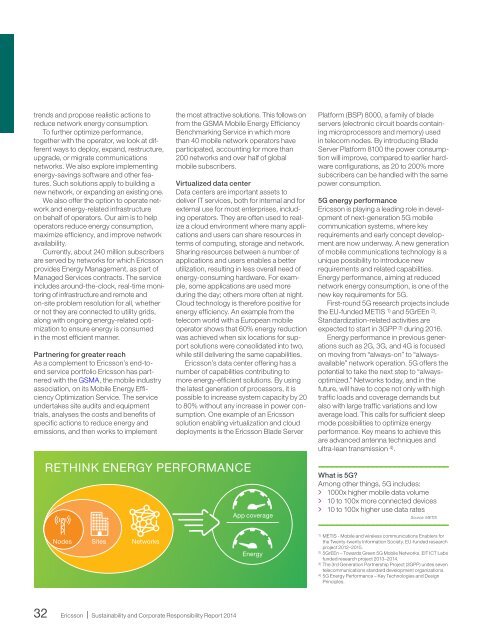OkCBP
OkCBP
OkCBP
Create successful ePaper yourself
Turn your PDF publications into a flip-book with our unique Google optimized e-Paper software.
trends and propose realistic actions to<br />
reduce network energy consumption.<br />
To further optimize performance,<br />
together with the operator, we look at different<br />
ways to deploy, expand, restructure,<br />
upgrade, or migrate communications<br />
networks. We also explore implementing<br />
energy-savings software and other features.<br />
Such solutions apply to building a<br />
new network, or expanding an existing one.<br />
We also offer the option to operate network<br />
and energy-related infrastructure<br />
on behalf of operators. Our aim is to help<br />
operators reduce energy consumption,<br />
maximize efficiency, and improve network<br />
availability.<br />
Currently, about 240 million subscribers<br />
are served by networks for which Ericsson<br />
provides Energy Management, as part of<br />
Managed Services contracts. The service<br />
includes around-the-clock, real-time monitoring<br />
of infrastructure and remote and<br />
on-site problem resolution for all, whether<br />
or not they are connected to utility grids,<br />
along with ongoing energy- related optimization<br />
to ensure energy is consumed<br />
in the most efficient manner.<br />
Partnering for greater reach<br />
As a complement to Ericsson’s end-toend<br />
service portfolio Ericsson has partnered<br />
with the GSMA, the mobile industry<br />
association, on its Mobile Energy Efficiency<br />
Optimization Service. The service<br />
undertakes site audits and equipment<br />
trials, analyses the costs and benefits of<br />
specific actions to reduce energy and<br />
emissions, and then works to implement<br />
the most attractive solutions. This follows on<br />
from the GSMA Mobile Energy Efficiency<br />
Benchmarking Service in which more<br />
than 40 mobile network operators have<br />
participated, accounting for more than<br />
200 networks and over half of global<br />
mobile subscribers.<br />
Virtualized data center<br />
Data centers are important assets to<br />
deliver IT services, both for internal and for<br />
external use for most enterprises, including<br />
operators. They are often used to realize<br />
a cloud environment where many applications<br />
and users can share resources in<br />
terms of computing, storage and network.<br />
Sharing resources between a number of<br />
applications and users enables a better<br />
utilization, resulting in less overall need of<br />
energy-consuming hardware. For example,<br />
some applications are used more<br />
during the day; others more often at night.<br />
Cloud technology is therefore positive for<br />
energy efficiency. An example from the<br />
telecom world with a European mobile<br />
operator shows that 60% energy reduction<br />
was achieved when six locations for support<br />
solutions were consolidated into two,<br />
while still delivering the same capabilities.<br />
Ericsson’s data center offering has a<br />
number of capabilities contributing to<br />
more energy-efficient solutions. By using<br />
the latest generation of processors, it is<br />
possible to increase system capacity by 20<br />
to 80% without any increase in power consumption.<br />
One example of an Ericsson<br />
solution enabling virtualization and cloud<br />
deployments is the Ericsson Blade Server<br />
Platform (BSP) 8000, a family of blade<br />
servers (electronic circuit boards containing<br />
microprocessors and memory) used<br />
in telecom nodes. By introducing Blade<br />
Server Platform 8100 the power consumption<br />
will improve, compared to earlier hardware<br />
configurations, as 20 to 200% more<br />
subscribers can be handled with the same<br />
power consumption.<br />
5G energy performance<br />
Ericsson is playing a leading role in development<br />
of next-generation 5G mobile<br />
communication systems, where key<br />
requirements and early concept development<br />
are now underway. A new generation<br />
of mobile communications technology is a<br />
unique possibility to introduce new<br />
requirements and related capabilities.<br />
Energy performance, aiming at reduced<br />
network energy consumption, is one of the<br />
new key requirements for 5G.<br />
First-round 5G research projects include<br />
the EU-funded METIS 1) and 5GrEEn 2) .<br />
Standardization-related activities are<br />
expected to start in 3GPP 3) during 2016.<br />
Energy performance in previous generations<br />
such as 2G, 3G, and 4G is focused<br />
on moving from “always-on” to “alwaysavailable”<br />
network operation. 5G offers the<br />
potential to take the next step to “alwaysoptimized.”<br />
Networks today, and in the<br />
future, will have to cope not only with high<br />
traffic loads and coverage demands but<br />
also with large traffic variations and low<br />
average load. This calls for sufficient sleep<br />
mode possibilities to optimize energy<br />
performance. Key means to achieve this<br />
are advanced antenna techniques and<br />
ultra-lean transmission 4) .<br />
RETHINK ENERGY PERFORMANCE<br />
App coverage<br />
What is 5G?<br />
Among other things, 5G includes:<br />
> > 1000x higher mobile data volume<br />
> > 10 to 100x more connected devices<br />
> > 10 to 100x higher use data rates<br />
Source: METIS<br />
Nodes<br />
Sites<br />
Networks<br />
Energy<br />
1) METIS - Mobile and wireless communications Enablers for<br />
the Twenty-twenty Information Society. EU-funded research<br />
project 2012–2015.<br />
2) 5GrEEn – Towards Green 5G Mobile Networks. EIT ICT Labs<br />
funded research project 2013–2014.<br />
3) The 3rd Generation Partnership Project (3GPP) unites seven<br />
telecommunications standard development organizations.<br />
4) 5G Energy Performance – Key Technologies and Design<br />
Principles.<br />
32 Ericsson | Sustainability and Corporate Responsibility Report 2014


